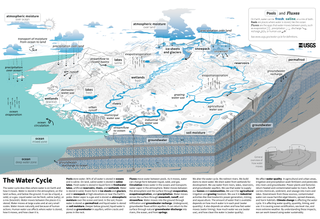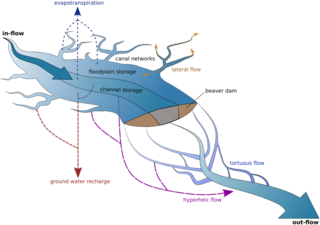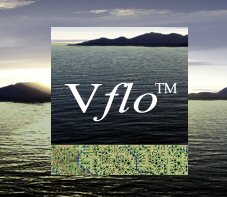Related Research Articles

Hydrology is the scientific study of the movement, distribution, and management of water on Earth and other planets, including the water cycle, water resources, and drainage basin sustainability. A practitioner of hydrology is called a hydrologist. Hydrologists are scientists studying earth or environmental science, civil or environmental engineering, and physical geography. Using various analytical methods and scientific techniques, they collect and analyze data to help solve water related problems such as environmental preservation, natural disasters, and water management.

A drainage basin is an area of land where all flowing surface water converges to a single point, such as a river mouth, or flows into another body of water, such as a lake or ocean. A basin is separated from adjacent basins by a perimeter, the drainage divide, made up of a succession of elevated features, such as ridges and hills. A basin may consist of smaller basins that merge at river confluences, forming a hierarchical pattern.

The water cycle, also known as the hydrologic cycle or the hydrological cycle, is a biogeochemical cycle that describes the continuous movement of water on, above and below the surface of the Earth. The mass of water on Earth remains fairly constant over time but the partitioning of the water into the major reservoirs of ice, fresh water, saline water and atmospheric water is variable depending on a wide range of climatic variables. The water moves from one reservoir to another, such as from river to ocean, or from the ocean to the atmosphere, by the physical processes of evaporation, transpiration, condensation, precipitation, infiltration, surface runoff, and subsurface flow. In doing so, the water goes through different forms: liquid, solid (ice) and vapor. The ocean plays a key role in the water cycle as it is the source of 86% of global evaporation.
Surface-water hydrology is the sub-field of hydrology concerned with above-earth water, in contrast to groundwater hydrology that deals with water below the surface of the Earth. Its applications include rainfall and runoff, the routes that surface water takes, and the occurrence of floods and droughts. Surface-water hydrology is used to predict the effects of water constructions such as dams and canals. It considers the layout of the watershed, geology, soils, vegetation, nutrients, energy and wildlife. Modelled aspects include precipitation, the interception of rain water by vegetation or artificial structures, evaporation, the runoff function and the soil-surface system itself.

Ecohydrology is an interdisciplinary scientific field studying the interactions between water and ecological systems. It is considered a sub discipline of hydrology, with an ecological focus. These interactions may take place within water bodies, such as rivers and lakes, or on land, in forests, deserts, and other terrestrial ecosystems. Areas of research in ecohydrology include transpiration and plant water use, adaption of organisms to their water environment, influence of vegetation and benthic plants on stream flow and function, and feedbacks between ecological processes, the soil carbon sponge and the hydrological cycle.

Infiltration is the process by which water on the ground surface enters the soil. It is commonly used in both hydrology and soil sciences. The infiltration capacity is defined as the maximum rate of infiltration. It is most often measured in meters per day but can also be measured in other units of distance over time if necessary. The infiltration capacity decreases as the soil moisture content of soils surface layers increases. If the precipitation rate exceeds the infiltration rate, runoff will usually occur unless there is some physical barrier.
The United States Environmental Protection Agency (EPA) Storm Water Management Model (SWMM) is a dynamic rainfall–runoff–subsurface runoff simulation model used for single-event to long-term (continuous) simulation of the surface/subsurface hydrology quantity and quality from primarily urban/suburban areas.

The law of water balance states that the inflows to any water system or area is equal to its outflows plus change in storage during a time interval. In hydrology, a water balance equation can be used to describe the flow of water in and out of a system. A system can be one of several hydrological or water domains, such as a column of soil, a drainage basin, an irrigation area or a city.

Groundwater recharge or deep drainage or deep percolation is a hydrologic process, where water moves downward from surface water to groundwater. Recharge is the primary method through which water enters an aquifer. This process usually occurs in the vadose zone below plant roots and is often expressed as a flux to the water table surface. Groundwater recharge also encompasses water moving away from the water table farther into the saturated zone. Recharge occurs both naturally and through anthropogenic processes, where rainwater and/or reclaimed water is routed to the subsurface.
Geographic information systems (GISs) have become a useful and important tool in the field of hydrology to study and manage Earth's water resources. Climate change and greater demands on water resources require a more knowledgeable disposition of arguably one of our most vital resources. Because water in its occurrence varies spatially and temporally throughout the hydrologic cycle, its study using GIS is especially practical. Whereas previous GIS systems were mostly static in their geospatial representation of hydrologic features, GIS platforms are becoming increasingly dynamic, narrowing the gap between historical data and current hydrologic reality.
Groundwater models are computer models of groundwater flow systems, and are used by hydrologists and hydrogeologists. Groundwater models are used to simulate and predict aquifer conditions.

A hydrologic model is a simplification of a real-world system that aids in understanding, predicting, and managing water resources. Both the flow and quality of water are commonly studied using hydrologic models.

The environmental effects of irrigation relate to the changes in quantity and quality of soil and water as a result of irrigation and the subsequent effects on natural and social conditions in river basins and downstream of an irrigation scheme. The effects stem from the altered hydrological conditions caused by the installation and operation of the irrigation scheme.

Vflo is a commercially available, physics-based distributed hydrologic model generated by Vieux & Associates, Inc. Vflo uses radar rainfall data for hydrologic input to simulate distributed runoff. Vflo employs GIS maps for parameterization via a desktop interface. The model is suited for distributed hydrologic forecasting in post-analysis and in continuous operations. Vflo output is in the form of hydrographs at selected drainage network grids, as well as distributed runoff maps covering the watershed. Model applications include civil infrastructure operations and maintenance, stormwater prediction and emergency management, continuous and short-term surface water runoff, recharge estimation, soil moisture monitoring, land use planning, water quality monitoring, and water resources management.
DPHM-RS is a semi-distributed hydrologic model developed at University of Alberta, Canada.

Saeid Eslamian is a full professor of Resilient Climate and Water Systems at Isfahan University of Technology in the Department of Water Science and Engineering. His research focuses mainly on statistical and environmental hydrology and climate change. In particular, he is working on forecasting natural hazards including flood, drought, storm, wind, pollution toward a sustainable environment. He is now the Director of Excellence in risk management and natural hazards. Formerly, he was a visiting professor at Princeton University, United States, university of ETH Zurich, Switzerland and McGill University, Montreal, Quebec, Canada. He has contributed to more than 600 publications in journals, books, or as technical reports. He is the founder and chief editor of International Journal of Hydrology Science and Technology. Currently, he has been the author of about 210 books and book chapters. Eslamian is the editorial board member and reviewer of about 100 Web of Science (ISI) Journals. Saeid is the editor of Journal of Hydrology (Elsevier)Journal of Hydrology, Ecohydrology and Hydrobiology (Elsevier), Journal of the Saudi Society of Agricultural Sciences (Elsevier), Journal of Water Reuse and Desalination (IWA).

Keith John Beven is a British hydrologist and distinguished emeritus professor in hydrology at Lancaster University. According to Lancaster University he is the most highly cited hydrologist.

The effects of climate change on the water cycle are profound and have been described as an intensification or a strengthening of the water cycle. This effect has been observed since at least 1980. One example is the intensification of heavy precipitation events. This has important negative effects on the availability of freshwater resources, as well as other water reservoirs such as oceans, ice sheets, atmosphere and land surface. The water cycle is essential to life on Earth and plays a large role in the global climate and the ocean circulation. The warming of our planet is expected to cause changes in the water cycle for various reasons. For example, warmer atmosphere can contain more water vapor which has effects on evaporation and rainfall.

Herman Bouwer (1927–2013) was a hydrological scientist who worked in groundwater hydrology and water resources management, with a specialization in the area of Managed Aquifer Recharge (MAR). He was born in the Netherlands and moved to the United States in 1952 to study for his PhD at Cornell University. He went on to work at the U.S. Water Conservation Laboratory, U.S. Dept. of Agriculture, serving as director from 1972 to 1990. His research efforts on characterizing and modeling the movement of water and pollutants in the vadose zone and groundwater resulted in field and analytical methods that are used in the groundwater sciences. He authored or co-authored over 300 publications and wrote the textbook Groundwater Hydrology.

Ezio Todini is an Italian academic, hydrologist and civil engineer.
References
- 1 2 3 4 5 Western, Andrew W. (2005). "Principles of Hydrological Measurements". In Anderson, Malcolm G. (ed.). Encyclopedia of Hydrological Sciences. Vol. 1. West Sussex, England: John Wiley & Sons Inc. pp. 75–94.
- ↑ Shuttleworth, W. James (January–February 2008). "Evapotranspiration Measurement Methods" (PDF). Southwest Hydrology. Tucson, AZ. 7 (1): 22–23. Retrieved 2009-07-22.
- ↑ "International Hydrological Programme (IHP)". IHP. 6 May 2013. Retrieved 8 June 2013.
- ↑ "International Water Management Institute (IWMI)". IWMI. Retrieved 8 March 2013.
- ↑ "UNESCO-IHE Institute for Water Education". UNIESCO-IHE. Archived from the original on 4 August 2007. Retrieved 8 March 2013.
- ↑ "CEH Website". Centre for Ecology & Hydrology. Retrieved 8 March 2013.
- ↑ "Cranfield Water Science Institute". Cranfield University. Retrieved 8 March 2013.
- ↑ "Eawag aquatic research". Swiss Federal Institute of Aquatic Science and Technology. 25 January 2012. Retrieved 8 March 2013.
- ↑ "Professur für Hydrologie". University of Freiburg. 23 February 2010. Retrieved 8 March 2013.
- ↑ "Water Resources of the United States". USGS. 4 October 2011. Retrieved 8 March 2013.
- ↑ "Office of Hydrologic Development". National Weather Service. NOAA. 28 October 2011. Retrieved 8 March 2013.
- ↑ "Hydrologic Engineering Center". US Army Corps of Engineers. Archived from the original on 8 March 2013. Retrieved 8 March 2013.
- ↑ "Hydrologic Research Center". Hydrologic Research Center. Retrieved 8 March 2013.
- ↑ "NOAA Economics and Social Sciences". NOAA Office of Program Planning and Integration. Archived from the original on 25 July 2011. Retrieved 8 March 2013.
- ↑ "Center for Natural Hazard and Disasters Research". University of Oklahoma. 17 June 2008. Archived from the original on 24 May 2013. Retrieved 8 March 2013.
- ↑ "National Hydrology Research Centre (Saskatoon, SK)". Environmental Science Centres. Environment Canada. Retrieved 8 March 2013.
- ↑ "National Institute of Hydrology (Roorkee), India". NIH Roorkee. Archived from the original on 19 September 2000. Retrieved 1 August 2015.
- ↑ "Hydrogeology Division". The Geological Society of America. 10 September 2011. Retrieved 8 March 2013.
- ↑ "Welcome to AGU's Hydrology (H) Section". American Geophysical Union. Retrieved 8 March 2013.
- ↑ "National Ground Water Association" . Retrieved 8 March 2013.
- ↑ "American Water Resources Association". 2 January 2012. Archived from the original on 24 March 2018. Retrieved 8 March 2013.
- ↑ "CUAHSI" . Retrieved 8 March 2013.
- ↑ "International Association of Hydrological Sciences (IAHS)". Associations. International Union of Geodesy and Geophysics. 1 December 2008. Retrieved 8 March 2013.
- ↑ "International Association of Hydrological Sciences" . Retrieved 8 March 2013.
- ↑ "International Commission on Statistical Hydrology". STAHY. Archived from the original on 6 June 2013. Retrieved 8 March 2013.
- ↑ Deutsche Hydrologische Gesellschaft, accessed 2 September 2013
- ↑ Nordic Association for Hydrology, accessed 2 September 2013
- ↑ "The British Hydrological Society" . Retrieved 8 March 2013.
- ↑ Гидрологическая комиссия [Hydrological Commission] (in Russian). Russian Geographical Society. Archived from the original on 26 August 2013. Retrieved 8 March 2013.
- ↑ "Hydroweb". The International Association for Environmental Hydrology. Retrieved 8 March 2013.
- ↑ "International Association of Hydrogeologists" . Retrieved 19 June 2014.
- ↑ "Connected Waters Initiative (CWI)". University of New South Wales. Retrieved 8 March 2013.
- ↑ "Integrated Water Resource Management in Australia: Case studies – Murray–Darling Basin initiative". Australian Government, Department of the Environment. Australian Government. Retrieved 19 June 2014.
- ↑ Wetzel, R.G. (2001) Limnology: Lake and River Ecosystems, 3rd ed. Academic Press. ISBN 0-12-744760-1